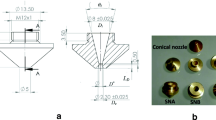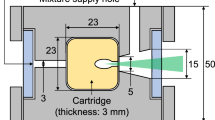Abstract
An inertial bubble collapsing near a solid boundary generates a fast impulsive microjet directed toward the boundary. The jet impacts the solid boundary at a high velocity, and this effect has been taken advantage of in industrial cleaning such as when tiny bubbles are driven ultrasonically to cavitate around machined parts to produce jets that are believed to induce the cleaning effect. In this experimental investigation, we are interested in the jetting from single cavities near a boundary. By introducing a through hole in the boundary beneath a laser-induced bubble, it is hypothesized that the forming jet, upon bubble implosion, will proceed to penetrate through the hole to the other side and that it may be utilized in useful applications such as precise surgeries. It was found that the growth of the bubble induced a fast flow through the hole and lead to the formation of secondary hydrodynamic cavitation. The experiments also showed the formation of a counter jet directed away from the hole and into the bubble. During the growth phase of the bubble, and near the point of maximum expansion, the bubble wall bulged out toward the hole in a ‘bulb’ like formation, which sometimes resulted in the pinching-off of a secondary small bubble. This was ensued by the inward recoiling of the primary bubble wall near the pinch-off spot, which developed into a counter jet seen to move away from the hole and inward into the bubble.














Similar content being viewed by others
Abbreviations
- \( t_{c} \) :
-
Bubble collapse time from inception to the point of minimum volume at first collapse
- \( R_{\hbox{max} } \) :
-
Bubble maximum radius
- \( \tau_{R} \) :
-
Rayleigh collapse time for a vaporous bubble
- \( \Updelta P = P_{\infty } - P_{v} \) :
-
Pressure difference between the liquid far away and the bubble interior (the interior pressure is given by the vapor pressure of water at the liquid temperature)
- \( \rho \) :
-
Liquid density
- L :
-
Distance from the boundary to the bubble center
- \( \gamma \) :
-
Non-dimensional distance from the center of the bubble to the boundary (normalized by the maximum bubble radius)
- k :
-
Collapse time prolongation factor for a non-spherical bubble; equal to the collapse time of the non-spherical deformed bubble normalized by the collapse time of a spherical bubble of equivalent radius. \( k = \frac{{t_{{c,\,{\text{deformed}}}} }}{{t_{{c,\,{\text{spherical}}}} }} \)
- \( R_{\text{hole}} \) :
-
Radius of the through hole drilled in the solid boundary
- \( \alpha \) :
-
Non-dimensional through hole radius (normalized by the bubble maximum radius) \( \alpha = \frac{{R_{\text{hole}} }}{{R_{\hbox{max} } }} \)
References
Blake R, Gibson DC (1987) Cavitation bubbles near boundaries. Annu Rev Fluid Mech 19:99–123
Blake JR, Robinson PB, Shima A, Tomita Y (1993) Interaction of two cavitation bubbles with a rigid boundary. J Fluid Mech 255:707–721
Brennen CE (1995) Cavitation and bubble dynamics. Oxford University Press, NY
Brennen CE (2002) Fission of collapsing cavitation bubbles. J Fluid Mech 472:153–166
Brujan E-A, Nahen K, Schmidt P, Vogel A (2001) Dynamics of laser-induced cavitation bubbles near an elastic boundary. J Fluid Mech 433:251–281
Chen Y-H, Lin I (2008) Dynamics of impacting a bubble by another pulsed-laser-induced bubble: jetting, fragmentation, and entanglement. Phys Rev E 77:026304
Chen H, Brayman AA, Bailey MR, Matula TJ (2009) Direct observation of microbubble interactions with ex vivo microvessels. J Acoust Soc Am 125(4):2680
Choi J-K, Chahine GL (2004) Noise due to extreme bubble deformation near inception of tip vortex cavitation. Phys Fluids 16(7):2411–2418
Choi J, Hsiao C-T, Chahine G, Ceccio S (2009) Growth, oscillation, and collapse of vortex cavitation bubbles. J Fluid Mech 624:255–279
Fletcher DA, Palanker DV (2001) Pulsed liquid microjet for microsurgery. Appl Phys Lett 78(13):1933–1935
Fong SW, Adhikari D, Klaseboer E, Khoo BC (2009) Interactions of multiple spark-generated bubbles with phase differences. Exp Fluids 46:705–724
Franc JP, Avellan F, Belhadji B et al (1995) La Cavitation: Mécanismes Physiques et Aspects Industriels. Presses Universitaires de Grenoble, France. ISBN: 2868834515, 9782868834515
Gharib M, Rambod E, Shariff K (1998) A universal time scale for vortex ring formation. J Fluid Mech 360:121–140
Godwin RP, Chapyak EJ, Noack J, Vogel A (1999) Aspherical bubble dynamics and oscillation times. In: Proceedings of the SPIE 3601, vol 225
Gopalan S, Katz J, Knio O (1999) The flow structure in the near fields of jets and its effect on cavitation inception. J Fluid Mech 398:1–43
Honl M, Rentzsch R, Schwieger K, Carrero V, Dierk O, Dries S, Louis H, Pude F, Bishop N, Hille E, Morlock M (2003) The water jet as a new tool for endoprosthesis revision surgery—an in vitro study on human bone and bone cement. Biomed Mater Eng 13:317–325
Ida M (2009) Bubble-bubble interaction: a potential source of cavitation noise. Phys Rev E 79:016307
Johnsen E, Colonius T (2008) Shock-induced collapse of a gas bubble in shockwave lithotripsy. J Acoust Soc Am 124(4):2011–2020
Karri B, Pillai KS, Klaseboer E, Ohl SW, Khoo BC (2011) Collapsing bubble induced pumping in a viscous fluid. Sens Actuators A 169:151–163
Khoo BC, Klaseboer E, Hung KC (2005) A collapsing bubble-induced micro-pump using the jetting effect. Sens Actuators 118:152–161
Kodama T, Takayama K, Uenohara H (1997) A new technology for revascularization of cerebral embolism using liquid jet impact. Phys Med Biol 42:2355–2367
Krieger JR, Chahine GL (2005) Acoustic signals of underwater explosions near surfaces. J Acoust Soc Am 118:2961–2974
Lauterborn W, Bolle H (1975) Experimental investigations of cavitation-bubble collapse in the neighborhood of a solid boundary. J Fluid Mech 72(pt 2):391–399
Lauterborn W, Ohl C-D (1997) Cavitation bubble dynamics. Ultrason Sonochem 4:65–75
Leighton TG (1994) The acoustic bubble. Academic Press, London. ISBN 0124419208
Lew KSF, Klaseboer E, Khoo BC (2007) A collapsing bubble-induced micropump: an experimental study. Sens Actuators A 133:161
Miller JM, Palancker DV, Vankov A, Marmor MF, Blumenkranz MS (2003) Precision and safety of the pulsed electron avalanche knife in vitreoretinal surgery. Arch Ophthalmol 121(6):871–877
Oweis GF, Choi J, Ceccio SL (2004) Dynamics and noise emissions of laser induced bubbles in a vortical flow field. J Acoust Soc Am 115(3):1049–1058
Oweis GF, van der Hout IE, Iyer C, Tryggvason G, Ceccio SL (2005) Capture and inception of bubbles near line vortices. Phys Fluids 17:022105
Pavard D, Klaseboer E, Ohl SW, Khoo BC (2009) Removal of particles from holes in submerged plates with oscillating bubbles. Phys Fluids 21:083304
Philipp A, Lauterborn W (1998) Cavitation erosion by single laser-produced bubbles. J Fluid Mech 361:75–116
Popinet S, Zaleski S (2002) Bubble collapse near a solid boundary: a numerical study of the influence of viscosity. J Fluid Mech 464:137–163
Rattray Jr M (1951) Perturbation effects in cavitation bubble dynamics. PhD thesis, California Institute of Technology
Rau HG, Meyer G, Cohnert TU, Schardey HM, Jauch K, Schildberg FW (1995) Laparoscopic liver resection with the water jet dissector. Surg Endosc 9:1009–1012
Shervani-Tabar MT, Mobadersany N, Mahmoudi SMS, Rezaee-Barmi A (2011) Velocity field and pressure distribution around a collapsing cavitation bubble during necking and splitting. J Eng Math 71:349–366
Siegman AE (1986) Lasers. University Science Books, Mill Valley. ISBN 0-935702-11-3
Tomita Y, Kodama T (2003) Interaction of laser-induced cavitation bubbles with composite surfaces. J Appl Phys 94(5):2809–2816
Tomita Y, Shima A, Sato K (1990) Dynamic behavior of two-laser-induced bubbles in water. Appl Phys Lett 57(3):234
Tomita Y, Robinson PB, Tong RP, Blake JR (2002) Growth and collapse of cavitation bubbles near a curved rigid boundary. J Fluid Mech 466:259–283
Wilhelm FH, Holtkamp A, Theurer A, Darman J Jr, Wilhelm L (1999) Examination of resistance of the lens capsule against the waterjet. Ophthalmologe 96:640–642
Xing T, Li Z, Frankel SH (2005) Numerical simulation of vortex cavitation in a three-dimensional submerged transitional jet. J Fluids Eng 127:714–725
Acknowledgments
Funding for this work was provided by the Arab Science and Technology Foundation (ASTF), project grant # HE06160. The major equipment was acquired with generous funding from the United States Agency for International Development/Office of American Schools and Hospitals Abroad (USAID/ASHA).
Author information
Authors and Affiliations
Corresponding author
Rights and permissions
About this article
Cite this article
Abboud, J.E., Oweis, G.F. The microjetting behavior from single laser-induced bubbles generated above a solid boundary with a through hole. Exp Fluids 54, 1438 (2013). https://doi.org/10.1007/s00348-012-1438-6
Received:
Revised:
Accepted:
Published:
DOI: https://doi.org/10.1007/s00348-012-1438-6




